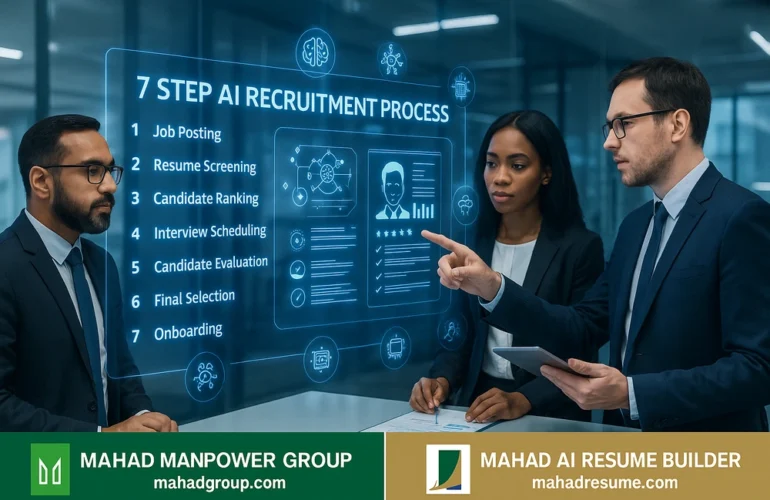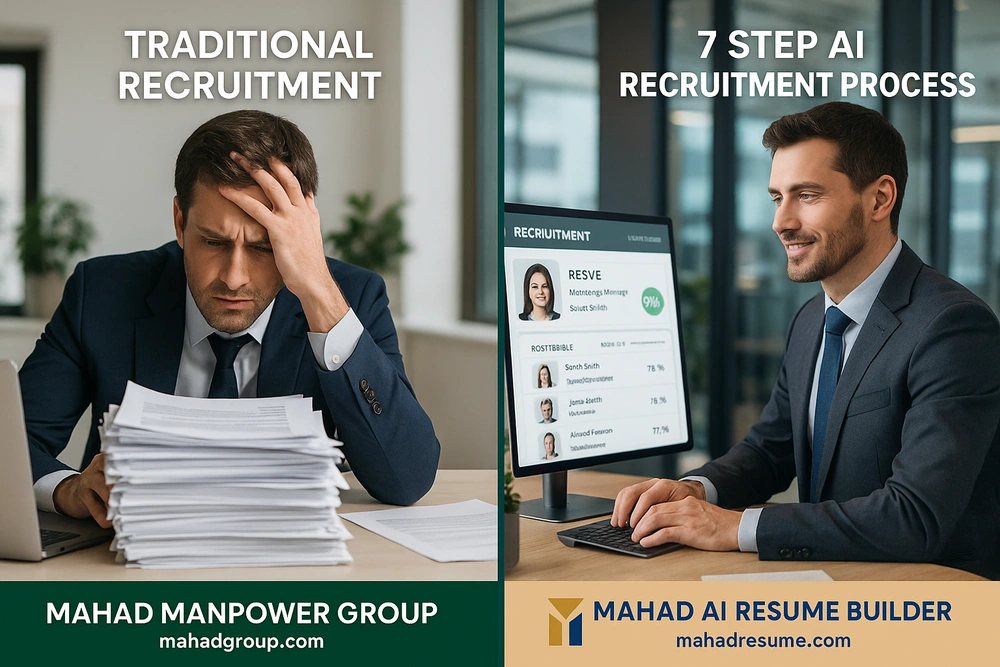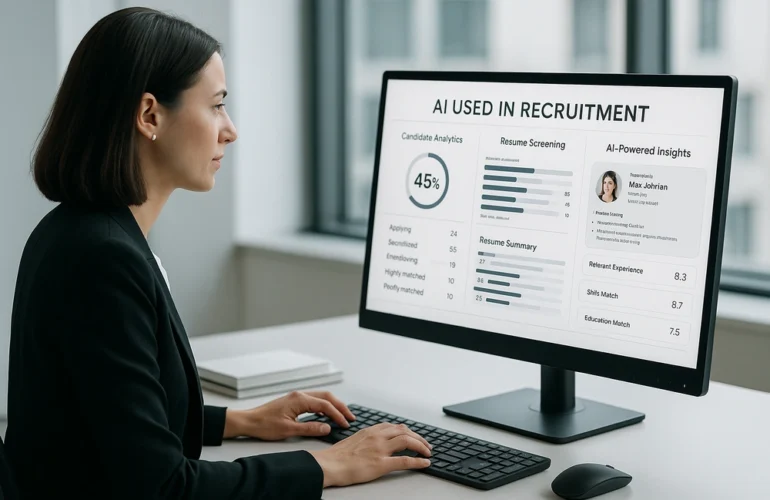7 Step AI Recruitment Process to Hiring Top Talent 2026
7 Step AI Recruitment Process to Hiring Top Talent in 2026. The recruitment landscape is undergoing a dramatic transformation. As we move into 2026, artificial intelligence has become the cornerstone of modern hiring strategies, enabling companies to identify and secure exceptional talent faster than ever before. The 7 Step AI Recruitment Process represents a comprehensive approach that combines cutting-edge technology with human expertise to revolutionise talent acquisition.
According to the U.S. Bureau of Labour Statistics, technological advances in recruitment are reshaping how organisations approach hiring, with AI playing an increasingly central role in workforce planning and talent management. Pro tip: AI in hiring
Understanding the 7 Step AI Recruitment Process
7 Step AI Recruitment Process: Traditional recruitment methods often consume valuable time and resources while delivering inconsistent results. The integration of AI into hiring processes addresses these challenges by automating repetitive tasks, eliminating unconscious bias, and providing data-driven insights that lead to superior hiring decisions. Companies implementing AI recruitment strategies report productivity gains exceeding 30% while significantly reducing time-to-hire.
Whether you’re exploring new career opportunities at mahadjobs.com or refining your professional profile, understanding how AI shapes modern recruitment gives you a competitive advantage in today’s job market. Stages of the recruitment process
Step 1: Intelligent Job Description Creation
The first step in the 7 Step AI Recruitment Process begins with crafting compelling job descriptions. AI-powered tools analyse thousands of successful job postings to generate optimised content that attracts qualified candidates. These systems ensure job descriptions include relevant keywords, clear requirements, and inclusive language that appeals to diverse talent pools.
AI can identify which phrases resonate with top performers in specific roles and automatically adjust tone and content to match your employer brand. This foundation sets the stage for attracting the right candidates from the outset.
Step 2: Automated Candidate Sourcing
7 Step AI Recruitment Process: Modern AI recruitment platforms cast a wider net than traditional methods. These systems scan multiple channels simultaneously, job boards, social media platforms, professional networks, and talent databases to identify potential candidates who match your criteria. Recruitment best practices
Advanced algorithms evaluate candidate profiles based on skills, experience, qualifications, and cultural fit indicators. This automated sourcing dramatically expands your talent pool while identifying passive candidates who might not be actively searching for opportunities but could be perfect matches for your organisation.
Step 3: Smart Resume Screening and Ranking
Perhaps the most time-consuming aspect of traditional recruitment is resume screening. The AI recruitment approach revolutionises this step by automatically analysing and ranking applications based on predefined criteria. AI systems can process thousands of resumes in minutes, extracting relevant information and identifying top candidates.
7 Step AI Recruitment Process: These tools focus on skills, qualifications, and experience rather than demographic factors, helping reduce unconscious bias in the selection process. Recruiters receive ranked candidate lists, allowing them to focus their energy on engaging with the most promising applicants.
For job seekers looking to optimise their resumes for AI screening systems, professional resume services like mahadresume.com can help ensure your application stands out in automated screening processes.
 Step 4: AI-Powered Pre-Screening Assessments
Step 4: AI-Powered Pre-Screening Assessments
The fourth step involves deploying intelligent pre-screening tools to evaluate candidate suitability. AI chatbots can conduct initial candidate interviews through conversational interfaces, asking relevant questions and assessing responses in real-time.
These assessments can evaluate technical skills, cognitive abilities, personality traits, and cultural alignment. Natural language processing enables AI systems to analyse candidate responses for communication skills, enthusiasm, and job-relevant competencies. This automated pre-screening ensures only qualified candidates advance to human interviews.
Step 5: Seamless Interview Scheduling and Coordination
Interview scheduling traditionally involves countless emails and calendar conflicts. The 7 Step AI Recruitment Process streamlines this through intelligent scheduling systems that coordinate availability across multiple stakeholders automatically.
AI-powered scheduling tools can arrange interviews within 24 hours of candidate qualification, significantly improving the candidate experience. These systems send automated reminders, handle rescheduling requests, and ensure smooth coordination between candidates and hiring teams.
Step 6: Data-Driven Candidate Evaluation
Modern AI recruitment leverages predictive analytics to assess candidate success probability. These systems analyse historical hiring data to identify patterns associated with top performers in specific roles.
According to human resources specialists who utilise AI tools, predictive analytics help determine which candidates are most likely to accept job offers, succeed in roles, and contribute long-term value to organisations. Interview transcription and analysis tools provide objective insights, reducing subjective bias in decision-making.
Step 7: Automated Offer Management and Onboarding
The final step in the AI recruitment framework involves generating personalised offer letters, managing negotiations, and facilitating seamless onboarding experiences. AI systems can personalise offers based on candidate preferences, market data, and internal equity considerations.
Once candidates accept, AI-powered onboarding platforms automate paperwork, coordinate training schedules, and match new hires with relevant resources based on their roles, learning styles, and career goals. This ensures new employees feel welcomed and prepared from day one.
Maximising Results with AI Recruitment
Successfully implementing the 7 Step AI Recruitment Process requires strategic planning and the right technology partners. Organisations should clearly define hiring objectives, select AI tools that align with their needs, and ensure their recruitment data is clean and organised for AI analysis.
While AI dramatically improves efficiency and outcomes, it works best when combined with human judgment and relationship-building. The technology handles data-intensive tasks, freeing recruiters to focus on meaningful candidate interactions and strategic talent decisions.
The Future of Talent Acquisition
7 Step AI Recruitment Process: As we progress through 2026, AI recruitment continues evolving with more sophisticated capabilities. Generative AI creates personalised candidate communications at scale, while advanced analytics predict workforce needs before positions become vacant.
Companies embracing the 7 Step AI Recruitment Process position themselves competitively in the talent marketplace. They attract better candidates faster, make more informed hiring decisions, and create superior experiences for both recruiters and applicants.
Process Importance
The integration of AI in recruitment isn’t about replacing human recruiters—it’s about empowering them with tools that eliminate tedious tasks and provide insights that were previously impossible to obtain. Organisations that adopt this structured, AI-enhanced approach to hiring will build stronger teams and achieve sustainable competitive advantages in their industries.


 Step 4: AI-Powered Pre-Screening Assessments
Step 4: AI-Powered Pre-Screening Assessments